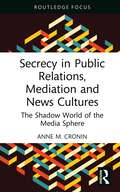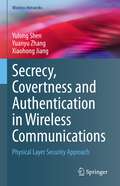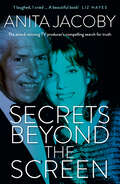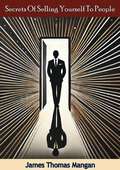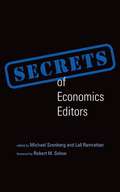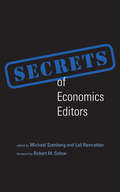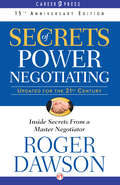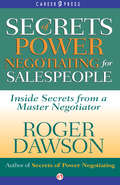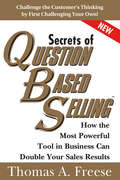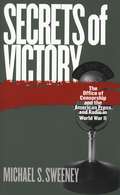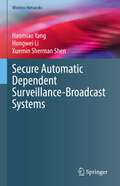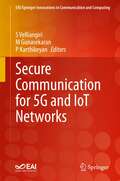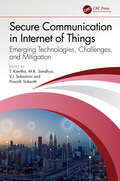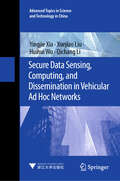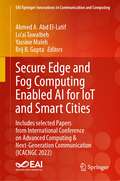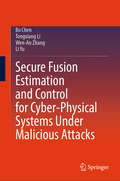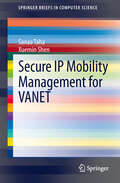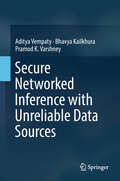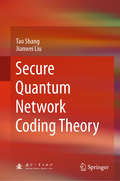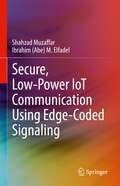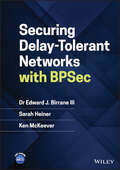- Table View
- List View
Secrecy in Public Relations, Mediation and News Cultures: The Shadow World of the Media Sphere (Routledge Focus on Media and Cultural Studies)
by Anne M. CroninThis book investigates the relationship of secrecy as a social practice to contemporary media, news cultures and public relations. Drawing on Georg Simmel’s theorisation of how secrecy produces a ‘second world’ alongside the ‘obvious world’ and creates and reshapes social relations, Anne Cronin argues for close analysis of the PR industry as a powerful vector of secrecy and an examination of its relationship to news cultures. Using case studies and in-depth interviews, as well as recent research in media and cultural studies, sociology, journalism studies and communication studies, the book analyses how PR practices generate a second, shadow world of the media sphere which has a profound impact on the ‘obvious world’. It interrogates both the PR industry’s and news culture’s role in shaping social relations for a digital media landscape, and those initiatives promoting transparency of data and decision-making processes. An insightful, interdisciplinary approach to debates on media and power, this book will appeal to students of public relations, sociology, media studies, cultural studies and communication studies. It will also be of interest to scholars and practitioners working at the intersections of media, social relations and public trust.
Secrecy, Covertness and Authentication in Wireless Communications: Physical Layer Security Approach (Wireless Networks)
by Xiaohong Jiang Yulong Shen Yuanyu ZhangThis book introduces the fundamentals of physical layer security (PLS) and demonstrates how a variety of PLS techniques can be applied to improve the security of wireless communication systems. In particular, this book covers three security aspects of wireless communications. It includes secrecy, i.e., preventing eavesdroppers from intercepting information from transmitted wireless signals, covertness, i.e., hiding the transmitted signals themselves from malicious wardens and authentication, i.e., authenticating the identities of communicating entities. When discussing the secrecy of wireless communication systems, this book covers physical layer secure communication in multiple-input multiple-out (MIMO) systems based on beamforming and precoding techniques, in relay systems based on link/relay selection and in large-scale random networks based on cooperative jamming. Regarding the covertness of wireless communication systems, this book introduces physical layer covert communication in relaying systems and MIMO systems. Also, when discussing authentication in wireless communication systems, this book introduces the implementation of physical layer authentication in MIMO systems based on channel features and/or radiometric features of transceivers. In addition, this book presents security-aware routing in wireless networks based on physical layer secure communication techniques.This book targets researchers in the fields of physical layer security and wireless communications security. Advanced-level students in electronic engineering or computer science studying these security topics will also want to purchase this book as a secondary textbook.
Secret Sauce: How to Pack Your Messages with Persuasive Punch
by Harry MillsWhen it comes to messaging, what worked in the past won’t work today. Our noisy, digital world has undermined our ability to focus.For a message to grab attention and persuade, it now has to pass the SAUCE test and be: Simple, Appealing, Unexpected, Credible, and Emotional.Secret Sauce shows you how to transform unconvincing messages into compelling copy. It comes with a 15-question SAUCE test and a Heat Gauge which allows you to precisely measure the persuasive impact of your messages. Short, easy to read, and packed with visuals, Secret Sauce provides:Clear examples of what works and what doesn’tFascinating insights from behavioral and neurological researchPowerful lessons from successful and failed campaignsLess than 10 percent of marketing messages are truly compelling—engaging the head and heart. Secret Sauce helps you weed out the clutter and craft messages that stick.
Secretos de liderazgo efectivo: El camino al éxito al alcance de todos
by José Luis ZavalaSECRETOS DE UN EMPRESARIO MEXICANO DE TALLA MUNDIAL PARA TRIUNFAR EN LA VIDA Y EN LOS NEGOCIOS José Luis Zavala, presidente del Consejo de Administración de CEMZA, el consorcio especializado en servicios offshore para la industria Oil & Gas y una de las 500 empresas más importantes de México, comparte a sus lectores consejos, herramientas, habilidades y conocimientos que fueron determinantes para impulsar su desarrollo profesional y personal. A lo largo de sus páginas Secretos de liderazgo efectivo reúne las anécdotas de vida que el autor ha experimentado a lo largo de su trayectoria en la consolidación de uno de los grupos empresariales más relevantes del país, desde cómo CEMZA logró ser la primera empresa mexicana en brindar servicios de recuperación de cápsulas aeroespaciales a la NASA hasta cómo ha solucionado conflictos del día adía en la rutina de un empresario mexicano, así como las lecciones que ha aprendido en el camino. Los 200 secretos de Zavala te ayudarán a mejorar actitudes, alcanzar objetivos, tomar riesgos, impulsar el crecimiento, mejorar la organización de tu empresa, desarrollar tu liderazgo, ser el mejor en atención al cliente, combatir la competencia, ser un excelente negociador, vender más, cuidar las finanzas de tu proyecto, solucionar problemas, enfrentar el cambio y motivar a la acción. Una extraordinaria guía de actitudes y habilidades para el camino hacia alcanzar tu misión, para crecer como líder y para llevar tu negocio al éxito. Un libro que podría cambiar tu vida para siempre.
Secrets Beyond the Screen: The award-winning TV producer's compelling search for truth
by Anita JacobyHow well does anyone know their family?Anita Jacoby AM is one of Australia&’s most distinguished television producers. Now she uncovers one of the most extraordinary stories of all, long hidden within her own family.The father Anita knew had fled persecution in Nazi Germany to settle in Australia and become a pioneer of the Australian communications industry. He was known and respected in the entertainment, political and business worlds. But he also had a devastating secret life.In her quest to establish the truth, Anita combines being a loving daughter with her investigative journalist skills, determined to find everything concealed from her family for more than seventy years. But by turning the camera on her father she&’s forced to question everything about him – and what she thought she knew about herself. And in discovering his secrets, she&’s compelled to reveal her own. This very Australian story is one of tragedy and rebirth, resilience and change. It&’s about love, grief, and the sacrifices parents make for their children. It&’s a story that proves that children, no matter how old or wise they become, never truly know their parents. &‘Surprising and stunning&’ - DI MORRISSEY AM&‘Heartfelt, heart-stopping&’ - HAMISH MACDONALD
Secrets Of Selling Yourself To People
by James Thomas ManganJames Thomas Mangan’s Secrets of Selling Yourself to People is a timeless guide to mastering the art of personal influence and building meaningful connections in both professional and personal settings. Packed with practical advice and actionable strategies, this book is an indispensable resource for anyone looking to improve their communication skills, win trust, and leave a lasting impression.Drawing on his extensive experience in sales and human behavior, Mangan breaks down the principles of self-presentation into clear, easy-to-follow steps. From cultivating confidence and charm to understanding the needs and motivations of others, he provides readers with the tools they need to become more persuasive and effective in any interaction.The book covers a wide range of topics, including:How to project a positive and memorable image.Techniques for effective listening and engaging conversations.Strategies for overcoming objections and building rapport.The psychology behind why people say "yes" and how to inspire trust.With its straightforward language and relatable examples, Secrets of Selling Yourself to People transcends its origins as a sales guide, offering valuable lessons for anyone looking to enhance their interpersonal skills. Whether you’re navigating the workplace, networking, or simply aiming to connect better with others, Mangan’s insights remain as relevant today as when they were first written.This book is perfect for professionals, entrepreneurs, and anyone seeking to unlock the secrets of human connection and persuasion. Mangan’s engaging style and practical wisdom make Secrets of Selling Yourself to People a must-read for achieving success through the power of personality.
Secrets of Economics Editors
by Michael Szenberg Lall Ramrattan Robert M. SolowEditors of academic journals are often the top scholars in their fields. They are charged with managing the flow of hundreds of manuscripts each year -- from submission to review to rejection or acceptance -- all while continuing their own scholarly pursuits. Tenure decisions often turn on who has published what in which journals, but editors can accept only a fraction of the papers submitted. In this book, past and present editors of economics journals discuss navigating the world of academic journals. Their contributions offer essential reading for anyone who has ever submitted a paper, served as a referee or associate editor, edited a journal -- or read an article and wondered why it was published. The editors describe their experiences at journals that range from the American Economic Review to the Journal of Sports Economics. The issues they examine include late referee reports, slow resubmission of manuscripts, and plagiarism -- as well as the difficulties of "herding cats" and the benefits of husband-wife editorial partnerships. They consider the role of the editor, as gatekeeper or developer of content; and they advise authors to write more carefully and clearly, to include citations that locate their articles in the context of the existing literature, and to update their work after it has been submitted and rejected elsewhere. The chapters also offer a timely, insider's perspective on the general effectiveness of the system of academic journals in economics. ContributorsRichard V. Adkisson, Richard G. Anderson, William A. Barnett, Suzanne R. Becker, William R. Becker, Daniel W. Bromley, William G. Dewald, Antony W. Dnes, Zvi Eckstein, Richard Friberg, Esther Gal-Or, Craufurd Goodwin, Thorvaldur Gylfason, Campbell R. Harvey, Geoffrey M. Hodgson, Leo H. Kahane, R. Preston McAfee, John Pencavel, Gerald Pfann, Steven Pressman, Lall B. Ramrattan, J. Barkley Rosser Jr., Paul H. Rubin, William F. Shughart II, Robert M. Solow, Daniel F. Spulber, Michael Szenberg, Timothy Taylor, Abu N.M. Wahid, Michael Watts, Lawrence J. White, Jürgen von Hagen, Fabrizio Zilibotti
Secrets of Economics Editors (The\mit Press Ser.)
by Michael Szenberg Lall RamrattanExperienced economics editors discuss navigating the world of scholarly journals, with details on submission, reviews, acceptance, rejection, and editorial policy.Editors of academic journals are often the top scholars in their fields. They are charged with managing the flow of hundreds of manuscripts each year—from submission to review to rejection or acceptance—all while continuing their own scholarly pursuits. Tenure decisions often turn on who has published what in which journals, but editors can accept only a fraction of the papers submitted. In this book, past and present editors of economics journals discuss navigating the world of academic journals. Their contributions offer essential reading for anyone who has ever submitted a paper, served as a referee or associate editor, edited a journal—or read an article and wondered why it was published.The editors describe their experiences at journals that range from the American Economic Review to the Journal of Sports Economics. The issues they examine include late referee reports, slow resubmission of manuscripts, and plagiarism—as well as the difficulties of “herding cats” and the benefits of husband-wife editorial partnerships. They consider the role of the editor, as gatekeeper or developer of content; and they advise authors to write more carefully and clearly, to include citations that locate their articles in the context of the existing literature, and to update their work after it has been submitted and rejected elsewhere. The chapters also offer a timely, insider's perspective on the general effectiveness of the system of academic journals in economics. ContributorsRichard V. Adkisson, Richard G. Anderson, William A. Barnett, Suzanne R. Becker, William R. Becker, Daniel W. Bromley, William G. Dewald, Antony W. Dnes, Zvi Eckstein, Richard Friberg, Esther Gal-Or, Craufurd Goodwin, Thorvaldur Gylfason, Campbell R. Harvey, Geoffrey M. Hodgson, Leo H. Kahane, R. Preston McAfee, John Pencavel, Gerald Pfann, Steven Pressman, Lall B. Ramrattan, J. Barkley Rosser Jr., Paul H. Rubin, William F. Shughart II, Robert M. Solow, Daniel F. Spulber, Michael Szenberg, Timothy Taylor, Abu N.M. Wahid, Michael Watts, Lawrence J. White, Jürgen von Hagen, Fabrizio Zilibotti
Secrets of Power Negotiating
by Roger DawsonRoger Dawson's Secrets of Power Negotiating has changed the way American business thinks about negotiating. Thinking "win-win"--looking for that magical third solution in which everyone wins but nobody loses--can be a naive and ultimately unsuccessful approach in today's tough business environment. Power Negotiating teaches that the way you negotiate can get you everything you want and still convince the other side that they won also. This third edition has been completely revised and updated to reflect the changing dynamics of business today. New and expanded sections include: Twenty sure-fire negotiating gambits. How to negotiate over the telephone, by e-mail, and via instant messaging. How to read body language. Listening to hidden meanings in conversation. Dealing with people from other cultures. How to become an expert mediator.Secrets of Power Negotiating covers every aspect of the negotiating process with practical, proven advice, from beginning steps to critical final moves: how to recognize unethical tactics, key principles of the Power Negotiating strategy, why money is not as important as everyone thinks, negotiating pressure points, understanding the other party and gaining the upper hand, and analyses of different negotiating styles.
Secrets of Power Negotiating for Salespeople
by Roger DawsonIn this revised and updated paperback edition, master negotiator Roger Dawson gives salespeople an arsenal of tools that can be implemented easily and immediately to enable a quantum leap in sales.
Secrets of Power Salary Negotiating
by Roger DawsonAre you earning what you're worth? Master negotiator Roger Dawson shows you how to get a better deal from your current employer and how to negotiate the best deal from a new employer. And you won't come off as greedy, overly aggressive, or selfish. In fact, you'll learn how to win salary negotiations and still leave your boss feeling like he or she has actually won! You'll also learn how to become more valuable to your employer or prospective employer, how to develop power and control over your career, and gain an amazing ability to get what you want.
Secrets of Question-Based Selling
by Thomas FreeseQuestion Based Selling ( QBS®) is a commonsense approach to sales, based on the theory that "what" salespeople ask-and "how" they ask-is more important than anything they will ever say. This technique makes sense because in order to present solutions, you first must learn your customer's needs.How do you uncover a prospect's needs? By asking questions. But not just any questions. You must ask the right questions at the right time. And this book provides a step-by-step, easy-to-follow program that does just that.With this proven, hands-on guide, you will learn to:--Penetrate more accounts--Establish greater credibility --Generate more return calls --Prevent and handle objections --Motivate different types of buyers--Develop more internal champions--Close more sales...faster--And much, much more
Secrets of Victory
by Michael S. SweeneyDuring World War II, the civilian Office of Censorship supervised a huge and surprisingly successful program of news management: the voluntary self-censorship of the American press. In January 1942, censorship codebooks were distributed to all American newspapers, magazines, and radio stations with the request that journalists adhere to the guidelines within. Remarkably, over the course of the war no print journalist, and only one radio journalist, ever deliberately violated the censorship code after having been made aware of it and understanding its intent.Secrets of Victory examines the World War II censorship program and analyzes the reasons for its success. Using archival sources, including the Office of Censorship's own records, Michael Sweeney traces the development of news media censorship from a pressing necessity after the attack on Pearl Harbor to the centralized yet efficient bureaucracy that persuaded thousands of journalists to censor themselves for the sake of national security. At the heart of this often dramatic story is the Office of Censorship's director Byron Price. A former reporter himself, Price relied on cooperation with--rather than coercion of--American journalists in his fight to safeguard the nation's secrets.
Secure Automatic Dependent Surveillance-Broadcast Systems (Wireless Networks)
by Xuemin Sherman Shen Hongwei Li Haomiao YangThis book proposes secure schemes to address security challenges in secure automatic dependent surveillance-broadcast systems (ADS-B) from five different angles. First, the authors examine encryption schemes applied to the ADS-B environment for protecting messages confidentiality. Second, they propose an ADS-B broadcast authentication scheme with batch verification by employing an identity-based signature. Third, they present ADS-B broadcast authentication scheme based on a digital signature with message recovery, which provides a feature that the message is recoverable from the signature. Fourth, they propose a new cryptographic solution to ADS-B security. Finally, they propose an accurate and efficient cognitive aircraft location verification scheme preserving aircraft location privacy by utilizing a grid-based k-nearest neighbor algorithm. In summary, the authors show how ADS-B data links can greatly enhance flight safety by these proposed schemes without sacrificing data security.Proposes several secure schemes to address security challenges in secure automatic dependent surveillance-broadcast systems (ADS-B);Provides extensive experiments and evaluates the proposed schemes using real-world data;Shows how ADS-B data links can greatly enhance safety without sacrificing data security
Secure Communication for 5G and IoT Networks (EAI/Springer Innovations in Communication and Computing)
by S. Velliangiri P. Karthikeyan M. GunasekaranThis book highlights research on secure communication of 5G and the Internet of Things (IoT) Networks, along with related areas to ensure secure and Internet-compatible IoT systems. The authors not only discuss 5G and IoT security and privacy challenges, but also energy efficient approaches to improving the ecosystems through communication. The book addresses the secure communication and privacy of the 5G and IoT technologies, while also revealing the impact of IoT technologies on several scenarios in smart city design. Intended as a comprehensive introduction, the book offers in-depth analysis and provides scientists, engineers and professionals the latest techniques, frameworks and strategies used in 5G and IoT technologies.
Secure Communication in Internet of Things: Emerging Technologies, Challenges, and Mitigation
by T. Kavitha Prasidh Srikanth M. K. Sandhya V. J. SubashiniThe book Secure Communication in Internet of Things: Emerging Technologies, Challenges, and Mitigation will be of value to the readers in understanding the key theories, standards, various protocols, and techniques for the security of Internet of Things hardware, software, and data, and explains how to design a secure Internet of Things system. It presents the regulations, global standards, and standardization activities with an emphasis on ethics, legal, and social considerations about Internet of Things security. Features:● Explores the new Internet of Things security challenges, threats, and future regulations to end-users.● Presents authentication, authorization, and anonymization techniques in the Internet of Things.● Illustrates security management through emerging technologies such as blockchain and artificial intelligence.● Highlights the theoretical and architectural aspects, foundations of security, and privacy of the Internet of Things framework.● Discusses artificial-intelligence-based security techniques, and cloud security for the Internet of Things.It will be a valuable resource for senior undergraduates, graduate students, and academic researchers in fields such as electrical engineering, electronics and communications engineering, computer engineering, and information technology.
Secure Control of Networked Control Systems and Its Applications
by Dong Yue Songlin Hu Zihao ChengThis book shows some secure control methods of networked control systems related to linear control system, nonlinear control system, multi-agent system and its applications in power systems. The proposed secure control methods provide some useful results about modeling of network attacks, resilient analysis and synthesis methods, active defense control method.The contents of this book are lists as followings. (1) Modeling of DoS attacks, deception attacks and replay attacks; (2)Secure control methods are proposed by combing delay system method, switched system method and event-based control method. (3) Active control methods are proposed by using model-predictive control and redundant control. (4) The proposed control methods are applied to the security problem of power system.The methods of this book include DoS attacks modeling such as, periodic jamming attack model,model-based average dwell time model, deception attack modeling and relay attack modeling; piece-wise Lyapunov-Krasoviskiifunctional method, stochastic control method; the results including resilient conditions of networked control system and related resilient control design method with linear matrix inequalities(LMIs).From this book, readers can learn about the general network attack modeling methods, resilient analysis and synthesis methods, active control methods from viewpoint of redundancy control, and secure conditions of power systems.Some fundamental knowledge prepared to read this book includes delay system theory, event triggered mechanism, T-S fuzzy system theory and frequency/voltage control of power system.
Secure Data Sensing, Computing, and Dissemination in Vehicular Ad Hoc Networks (Advanced Topics in Science and Technology in China #1)
by Yingjie Xia Xuejiao Liu Huihui Wu Qichang LiThis book focuses on the fields of security of vehicular ad hoc networks (VANETs). Building upon previous research findings, it conducts research on three modules: secure data sensing, computing, and dissemination in VANETs. The book adopts a combination of security analysis, theoretical analysis, and simulation analysis to comprehensively evaluate and demonstrate the effectiveness and performance of proposed solutions. It aims to assist other researchers in conducting studies on the data security issues of vehicular ad hoc networks, while designing secure and efficient schemes.
Secure Edge and Fog Computing Enabled AI for IoT and Smart Cities: Includes selected Papers from International Conference on Advanced Computing & Next-Generation Communication (ICACNGC 2022) (EAI/Springer Innovations in Communication and Computing)
by Brij B. Gupta Yassine Maleh Lo’ai Tawalbeh Ahmed A. Abd El-LatifThis book gathers recent research in security and privacy to discuss, evaluate, and improve the novel approaches of data protection in IoT and edge and fog computing. The primary focus of the book addresses security mechanisms in IoT and edge/ fog computing, advanced secure deployments for large scaled edge/ fog computing, and new efficient data security strategy of IoT and edge/ fog computing. The book lays a foundation of the core concepts and principles of IoT and 5G security, walking the reader through the fundamental ideas. This book is aimed at researchers, graduate students, and engineers in the fields of secure IoT and edge/ fog computing. The book also presents selected papers from International Conference on Advanced Computing & Next-Generation Communication (ICACNGC 2022).
Secure Fusion Estimation and Control for Cyber-Physical Systems Under Malicious Attacks
by Wen-An Zhang Bo Chen Li Yu Tongxiang LiThe book focuses on the issues of secure fusion estimation and control in cyber-physical systems under cyber-attacks, such as privacy protection under eavesdropping attacks, security fusion estimation under DoS and FDI attacks, and model-based and model-free security control under cyber-attacks. The comprehensive and systematic treatment of security protection in cyber-physical systems is one of the main features of the book, which is particularly suitable for readers interested in learning practical solutions for the security of cyber-physical systems. The book can benefit researchers, engineers and graduate students in the fields of control science and engineering, computer science, communication engineering, etc.
Secure IP Mobility Management for VANET
by Xuemin Shen Sanaa TahaThis brief presents the challenges and solutions for VANETs' security and privacy problems occurring in mobility management protocols including Mobile IPv6 (MIPv6), Proxy MIPv6 (PMIPv6), and Network Mobility (NEMO). The authors give an overview of the concept of the vehicular IP-address configurations as the prerequisite step to achieve mobility management for VANETs, and review the current security and privacy schemes applied in the three mobility management protocols. Throughout the brief, the authors propose new schemes and protocols to increase the security of IP addresses within VANETs including an anonymous and location privacy-preserving scheme for the MIPv6 protocol, a mutual authentication scheme that thwarts authentication attacks, and a fake point-cluster based scheme to prevent attackers from localizing users inside NEMO-based VANET hotspots. The brief concludes with future research directions. Professionals and researchers will find the analysis and new privacy schemes outlined in this brief a valuable addition to the literature on VANET management.
Secure Networked Inference with Unreliable Data Sources
by Aditya Vempaty Bhavya Kailkhura Pramod K. VarshneyThe book presents theory and algorithms for secure networked inference in the presence of Byzantines. It derives fundamental limits of networked inference in the presence of Byzantine data and designs robust strategies to ensure reliable performance for several practical network architectures. In particular, it addresses inference (or learning) processes such as detection, estimation or classification, and parallel, hierarchical, and fully decentralized (peer-to-peer) system architectures. Furthermore, it discusses a number of new directions and heuristics to tackle the problem of design complexity in these practical network architectures for inference.
Secure Quantum Network Coding Theory
by Tao Shang Jianwei LiuThis is the first book on secure quantum network coding, which integrates quantum cryptography into quantum communication. It summarizes the main research findings on quantum network coding, while also systematically introducing readers to secure quantum network coding schemes. With regard to coding methods, coding models and coding security, the book subsequently provides a series of quantum network coding schemes based on the integration of quantum cryptography into quantum communication. Furthermore, it describes the general security analysis method for quantum cryptographic protocols. Accordingly, the book equips readers with effective tools for researching and applying quantum network coding.
Secure, Low-Power IoT Communication Using Edge-Coded Signaling
by Ibrahim (Abe) Elfadel Shahzad MuzaffarThis book discusses single-channel, device-to-device communication in the Internet of Things (IoT) at the signal encoding level and introduces a new family of encoding techniques that result in significant simplifications of the communication circuitry. These simplifications translate into lower power consumption, smaller form factors, and dynamic data rates that are tolerant to clock discrepancies between transmitter and receiver. Readers will be introduced to signal encoding that uses edge-coded signaling, based on the coding of binary data as counts of transmitted pulses. The authors fully explore the far-reaching implications of these novel signal-encoding techniques and illustrate how their usage can help minimize the need for complex circuitries for either clock and data recovery or duty-cycle correction. They also provide a detailed description of a complete ecosystem of hardware and firmware built around edge-code signaling. The ecosystem comprises an application-specific processor, automatic protocol configuration, power and data rate management, cryptographic primitives, and automatic failure recovery modes. The innovative IoT communication link and its associated ecosystem are fully in line with the standard IoT requirements on power, footprint, security, robustness, and reliability.
Securing Delay-Tolerant Networks with BPSec
by Edward J. Birrane III Sarah Heiner Ken McKeeverSecuring Delay-Tolerant Networks with BPSec One-stop reference on how to secure a Delay-Tolerant Network (DTN), written by experienced industry insiders Securing Delay-Tolerant Networks with BPSec answers the question, “How can delay-tolerant networks be secured when operating in environments that would otherwise break many of the common security approaches used on the terrestrial Internet today?” The text is composed of three sections: (1) security considerations for delay-tolerant networks, (2) the design, implementation, and customization of the BPSec protocol, and (3) how this protocol can be applied, combined with other security protocols, and deployed in emerging network environments. The text includes pragmatic considerations for deploying BPSec in both regular and delay-tolerant networks. It also features a tutorial on how to achieve several important security outcomes with a combination of security protocols, BPSec included. Overall, it covers best practices for common security functions, clearly showing designers how to prevent network architecture from being over-constrained by traditional security approaches. Written by the lead author and originator of the BPSec protocol specification, Securing Delay-Tolerant Networks (DTNs) with BPSec includes information on: The gap between cryptography and network security, how security requirements constrain network architectures, and why we need something different DTN stressing conditions, covering intermittent connectivity, congested paths, partitioned topologies, limited link state, and multiple administrative controls Securing the terrestrial internet, involving a layered approach to security, the impact of protocol design on security services, and securing the internetworking and transport layers A delay-tolerant security architecture, including desirable properties of a DTN secure protocol, fine-grained security services, and protocol augmentation Securing Delay-Tolerant Networks (DTNs) with BPSec is a one-stop reference on the subject for any professional operationally deploying BP who must use BPSec for its security, including software technical leads, software developers, space flight mission leaders, network operators, and technology and product development leaders in general.
